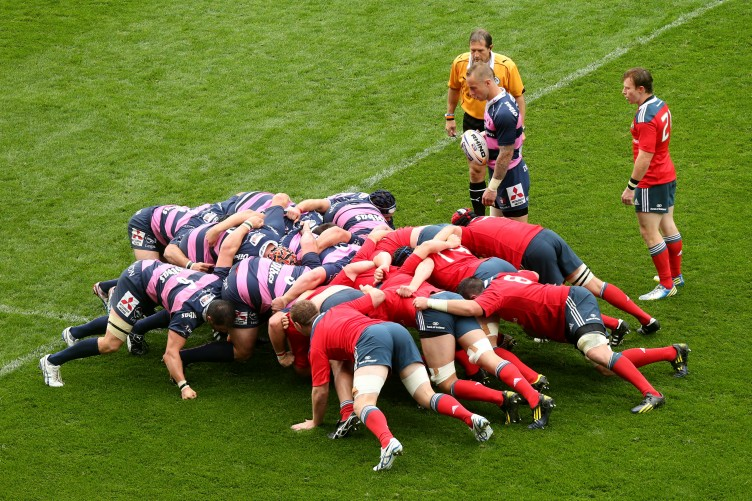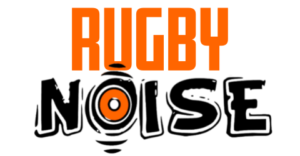All widely-recognized sports, especially the professional kind, have their own lingo. Soccer has its free kicks, corner kicks, and offsides, and basketball (for leagues like the NBA) has the free throw, the three-pointer, and the four-point play. To the uninitiated, some if not most of these terms are categorized as jargon or are the subject of heated discussions among fans who struggle to agree on a uniform definition. Rugby is no exception as they have its own head-scratching terminology in the scrum and the ruck.
What is the difference between a scrum and a ruck? A scrum is a process through which play is resumed after either team commits a penalizable offense. Players from both teams (up to eight in number) interlock and compete for the ball which is fed in through the gap between them commonly referred to as the tunnel. A ruck, on the other hand, occurs during play where a player from one team is successfully tackled by an opposing player. Supporting players then huddle up over the downed player who may have possession of the ball and push their opponents to help retain it as the opposing team does the same in an attempt to “steal” it.

In-depth Definitions
As previously stated, arguably the most important distinguishing factor between a scrum and a ruck is that the former happens to resume play after it was temporarily suspended to address an infraction caused by either team while the latter is a scramble by players from either team to win possession of the ball after a successful tackle.
Other factors or variables may apply but the underlying principle is the same: a scrum restarts play whereas a ruck continues play. Naturally, there are strict regulations governing both, and depending on how a play develops, one can result in the other and vice versa.
Scrums are arguably the more technical of the two. As such, people are more likely to have a hard time understanding them. They have such as steep learning curve that even players themselves fail to follow the rules and end up being slapped with more penalties like free kicks for their opponents.
Though scrums may be a bit technical, the logic behind them is quite easy – an infraction occurred and play must resume. Since both teams may have equal claim to possession, the only fair way to resolve it would be to give both of them an equal chance to win possession.
In the rugby union, each team provides eight players (forwards) who traditionally form three rows as follows: the first row involves three players – two props (tighthead prop on the right and the loosehead prop on the left) and the hooker between them.
The second row comprises two players who fortify or “lock” the first three (and thus the entire scrum) in place while the third row is made up of two flankers (an openside flanker positioned on the larger field-facing side and a blindside flanker on the smaller side near the touchline). The eighth player equally positions himself behind the third row.
A scrum occurs in three stages of commands normally given by the referee: crouch, bind, and set. The first stage (crouch) sees the players get low in preparation to engage. The second stage (bind) sees the two props in the first row “bind” around the hooker from the outside of their arms to the outside of their shoulders. The second and third rows and the eighth player also join the corresponding spaces.
Set allows the front rows to engage and push their opponents as the ball is introduced into the tunnel. In the rugby union’s “younger sibling”, rugby sevens, scrums involve only the three players in the front row from both teams. They are therefore considerably.
Once the ball is introduced, the players in the first row (tighthead prop, loosehead proper, and hooker) push their opponents and try to hook the ball backward using only their feet. The scrum-half or eighth player of the side that emerges victorious then picks the ball and proceeds to continue the play.
Player Conduct
Since scrums and rucks tend to happen in close quarters, a number of rules need to be followed by players from both teams in order to ensure fairness and safety. Players, especially those in the front row need to engage squarely and not at odd angles in order to get an advantage.
Pulling twisting or tugging at the opposing team’s clothing in order to gain an undue advantage or collapse the scrum is also strictly forbidden. The back row is also required to remain engaged until the ball exits the scrum.
The scrum-half tasked with feeding the ball into the tunnel must do so without delay as soon as the scrum is properly formed since the scrum only officially begins after the ball leaves his/her hands. Any delays or improper feeding of the ball results in a penalty and the opposition being awarded a free-kick.
Blurred Lines
Some rugby connoisseurs have defined a ruck as a mini-scrum, which if considered objectively, is an accurate definition. Since rucks form during play, it is mostly the nearest supporting players (regardless of their position) who join in to help their teammate or to attempt to use their opponents’ misfortune to their advantage.
The minimum threshold for a ruck is that at least one player from either team is over the ball which may either be on the ground or in the possession of the tackled player who shields it from their opponents by putting the ball on their side of the field and shielding it with his body.
According to rugby laws, only players who are able to get control of the ball (with their hands) and stay on their feet before the ruck is formed can handle it (use their hands). Downed players from either team must do their best to move away from the ball.
Once either team clearly wins possession of the ball, the referee acknowledges it with the words “use it”. The victorious team is then given only five seconds to do so. Violating the five-second allowance given results in a scrum being awarded to the opposing team.
